PDF Attached
US
equity and most commodity markets traded lower. Attached is our US wheat production by class tables and US balance. US corn and soybean conditions improved one point each, and both were one point above trade expectations.


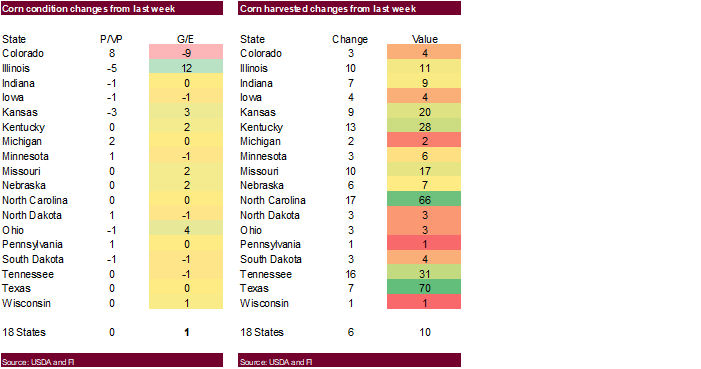

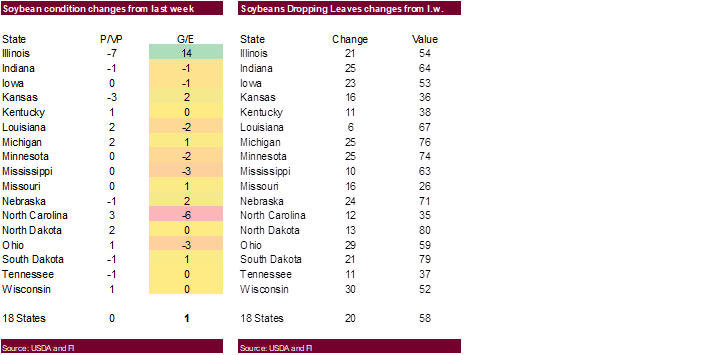
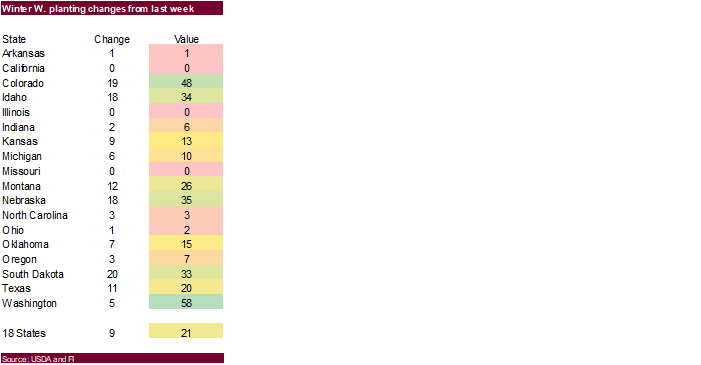

7-day
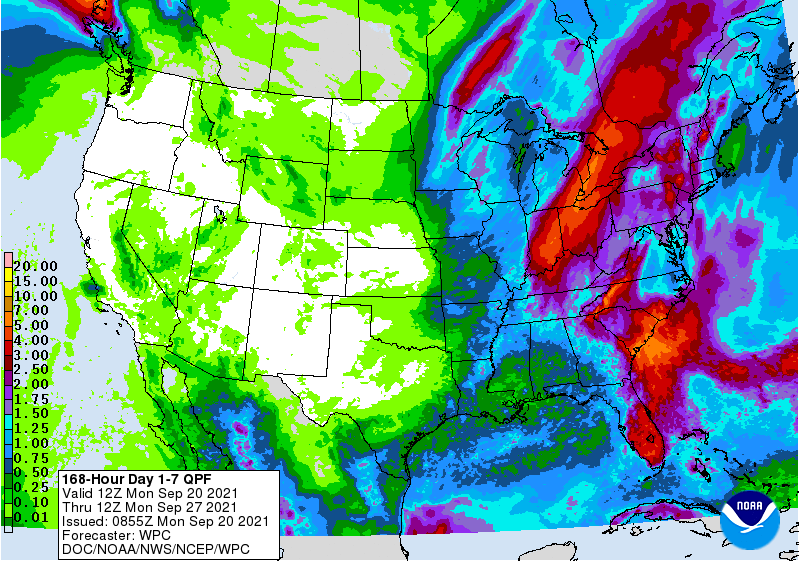
MOST
IMPORTANT WEATHER FOR THE COMING WEEK
- U.S.
weather early this week will include showers and thunderstorms in northern and eastern parts of the Midwest as well as the Delta, Tennessee River Basin and southeastern states as tropical moisture lifts northward from the Gulf of Mexico Coast States to merge
with a mid-latitude frontal system moving west to east across the eastern Midwest resulting in moderate to locally heavy rain
o
Moisture totals by Wednesday afternoon will range from 0.10 to 0.75 inch of rain in the western Corn Belt with local totals of 1.00 to 2.00 inches in eastern and northern Minnesota and Wisconsin
o
Rainfall of 1.00 to 4.00 inches will occur in Indiana, Ohio, Kentucky southeastern Michigan
o
Rainfall of 0.10 to 0.75 inch and local totals over 1.00 inch will impact the Delta
o
Rainfall of 0.75 to 2.50 inches in the southeastern states with a few areas in the Carolinas getting 2.50 to more than 4.00 inches
- U.S.
Plains, far western Corn Belt and most of the far western U.S. crop areas will not get enough rain to counter evaporation during the next ten to two weeks
o
Dryness could be quite persistent resulting in soil moisture depletion, a decline in grazing conditions, poor unirrigated winter crop emergence, and establishment and a rising level of worry over water supply in the western half
of the nation
o
An upper level low pressure center will move through southern California to the Great Basin producing some showers late this week into the weekend
- U.S.
temperatures in this coming week will be warmer than usual in the Plains and areas west to the Pacific Coast as well as in New England
o
Temperatures will be near to below average in the interior southeastern states
- Soft
frost is expected in Tuesday into Thursday mornings from the eastern Dakotas to upper Michigan and Wisconsin - None
of the frost should seriously harm crops - Lowest
temperatures will slip to the 30s Fahrenheit - U.S.
temperatures next week will be cooler in the Midwest and northern Plains while warmer than usual weather continues in the far western U.S.
- U.S.
weekend weather included net drying in the Midwest, much of the Great Plains and the southwestern states
o
Showers occurred in a narrow band from the Rolling Plains of West Texas northward into central Kansas and interior eastern Nebraska where moisture totals ranged up to 0.60 inch
o
Rain and thunderstorms were more generalized during the Friday through Sunday period from the Delta east into eastern Tennessee, western and central Georgia and Florida
- Rainfall
varied from 1.00 to nearly 4.00 inches from the Tennessee River Basin and southwestern Kentucky to western and south-central Georgia and northern Florida - A
few areas in southern Mississippi and eastern and northern Louisiana also reported 1.00 to more than 2.00 inches of rain with McComb, MS reporting 3.07 inches
o
Rain fell significantly from the Cascade Mountains to the Pacific Coast as far south as the uppermost California coast
- Moisture
totals ranged from 1.00 to 3.13 inches in much of this region bolstering soil moisture - The
precipitation did not reach significantly into the Yakima Valley, the Columbia River Valley or the Snake River Valley, although a few light showers occurred in these areas
o
Temperatures were quite warm to hot in the northwestern U.S. Plains where 90-degree highs were noted
- Similar
hot conditions occurred from the central Plains and lower Midwest into the southern Plains where readings in the 90s were common
- Many
other Midwestern, Delta and southeastern states’ crop areas were in the 80s with a few lower 90s and a couple of upper 70s - No
crop threatening cold occurred in key crop areas - Canada’s
Prairies were unseasonably hot during the weekend with 80- and lower 90-degree highs in the heart of Saskatchewan while 60s and 70s occurred in many other areas.
o
Some locations in far western Canada were no warmer than the 50s Fahrenheit
o
Lowest temperatures were in the 30s and 40s in the west and 40s and lower 50s central and east
- Canada
Prairies weather this week will be warmer and drier than usual, although totally dry conditions are unlikely
o
Despite the warm bias, frost and some freezes will be widespread in Saskatchewan and Manitoba Tuesday morning
- Warming
is expected the remainder of this week
o
Warmer than usual conditions will continue next week as well
o
Precipitation will be restricted
- Ontario
and Quebec, Canada weather will briefly turn wetter this week resulting in some summer crop maturation and harvest delays
o
Rainfall will be greater than usual this week and more seasonable next week
o
Temperatures will be near to above normal
- Tropical
Storm Peter was located near 19.1 north, 59.5 west at 0500 EDT today which was 245 miles east of the Northern Leeward Islands moving west northwesterly at 17 mph and producing maximum sustained wind speeds of 50 mph
o
Tropical storm force wind was occurring out 125 miles
o
A slow weakening trend will begin today and last through mid-week
o
The storm will pass to the northeast of the Antilles and then turn to the northeast away from North America
o
Peter may be downgraded to depression status as it turns to the north and then to the northeast
o
The storm could influence Bermuda during the coming weekend, but the system may pass to the southeast of the island
- Tropical
Storm Rose was located 550 miles west of the southernmost Cabo Verde Islands at 0500 EDT today from a position near 15. 9 north, 32.6 west moving northwesterly at 15 mph and producing maximum sustained wind speeds of 40 mph up to 35 miles from the storm center
o
Rose will continue moving northwesterly through mid-week and then begin to weaken late this week over open water in the central Atlantic Ocean
o
The storm poses no threat to land through the first half of next week
- A
tropical wave moving off the Africa west coast early this week has potential to become a tropical cyclone late this week over the eastern tropical Atlantic Ocean with movement toward the Lesser Antilles next week
o
The storm will not likely have strong support for significant development, but it will be closely monitored
- Remnants
of Tropical Storm Odette in the northwestern Atlantic Ocean have “some” potential for redevelopment during mid-week this week as the system moves to lower Latitudes, but there would be no threat to North America - Argentina
weather was mostly dry during the weekend, but some rain evolved in the southwest Sunday and early today
o
Rainfall of 0.10 to 0.75 inch resulted in La Pampa, far western Buenos Aires, San Luis and far southwestern Cordoba with local totals over 1.00 inch in far southwestern Buenos Aires and southeastern La Pampa
o
Totally dry weather is not likely over the next seven days, but most of the precipitation that falls will be a little too sporadic and light for a serious change in topsoil moisture or crop conditions – especially in the driest
areas
- The
areas that need moisture most will likely only experience light showers and minimal relief
o
Week two of the outlook will induce greater rainfall in southern and eastern parts of the nation, but the north and west-central parts will remain too dry
o
A moisture boost must occur soon in northern and western crop areas to support winter wheat and early season planting of spring crops
- As
of Thursday, sunseed planting was 14% done compared to 23% last year. - Brazil
weather during the weekend was seasonably dry and warm to hot across the center west and center south while scattered showers and thunderstorms occurred in the far south
o
Highest afternoon temperatures were in the 90s to 104 degrees Fahrenheit with extremes to 106 in northern Paraguay
o
Rain was significant in northern Rio Grande do Sul where 0.25 to 1.57 inches resulted through Sunday morning with Paso Fundo reporting 2.04 inches
- Brazil
will continue very warm to hot in the center west and center south this workweek with minimal precipitation
o
Showers will occur in the far south, but significant moisture will not be very great
o
Showers will develop in center west and center south this weekend and continue periodically next week
- Sufficient
rain will fall in “some” areas to lift topsoil moisture for better early season soybean and early corn planting. Greater rainfall will still be needed before aggressive fieldwork can begin; however, any precipitation will be better than none.
- Rain
is advertised to increase in many areas during the final days in September and early days in October - Europe
weather this week is expected to be favorably mixed with a little rain and some sunshine. Southern parts of the continent will be wettest
o
Next week’s weather is expected to be wetter biased in France, the U.K., Germany and northern Italy
o
Eastern Europe will be drier than usual next week
o
Temperatures will be near normal this week and then cooler than usual in the west and warmer usual in the east
- Europe
weather during the weekend was wettest in France and from eastern Poland through Belarus and parts of Ukraine into western Russia
o
Net drying occurred elsewhere
o
Temperatures were mil to warm
- Belarus
and southwestern Russia received rain during the weekend along with portions of Ukraine all of which benefited winter wheat, rye and barley germination, emergence and future establishment
o
Rainfall varied from 1.00 to 3.00 inches from Belarus into southwestern Russia while varying from 0.50 to 1.57 inches in most other areas, although as much as 4.00 inches occurred at one central Ukraine location
o
Showers also occurred in Russia’s eastern New Lands
o
Temperatures were mild to cool west of the Ural Mountains and warmer than usual in Kazakhstan
- Eastern
China will experience too much rain again over this coming week
o
The Yellow River Basin and North China Plain will be wetter than usual this week with rainfall well above average varying from northeastern Sichuan and Shaanxi to the northeastern provinces during the next ten days
- Rain
today will be greatest in the North China Plain and northeastern provinces, but will be greatest in the second half of this week, into the weekend and next week in the Yellow River Basin
- Some
heavy rain is expected which may delay summer crop harvesting and early autumn wheat planting, but the moisture will be good for long term crop development during the balance of Autumn
o
Temperatures will be near to above normal
- Rain
in China next week will concentrate between the Yellow River and the southern Yangtze River Basin
o
Resulting rainfall will be greater than usual in that region while needed drying begins near and north of the Yellow River
o
Temperatures will be near to above average
- India
weather during the weekend was quite limited in the far north and interior south while showers occurred lightly in other areas
o
Temperatures were seasonable to a bit warmer than usual with the north warmest relative to normal
- India’s
monsoon will continue undaunted by seasonal weather changes this week or early next week
o
Rain will fall frequently most of the nation with the interior south staying driest this week, but getting a little wetter next week
o
Rainfall will be well above average this week in central and northwestern parts of the nation and neighboring Pakistan
o
Temperatures will be near normal with a slight cooler than usual bias in the wettest areas
- Australia
rainfall during the weekend was greatest in New South Wales and Victoria where up to 0.45 inch resulted
o
The precipitation was good for winter wheat, barley and canola development
o
Dryness continues in Queensland and needs to be relieved soon to induce good spring planting conditions
- Dryness
has already lasted long enough to cut into some Queensland dryland wheat and barley yields
o
All other Australia’s winter crop production potentials are still high with little change likely
o
Temperatures will be a little cooler than usual in the southeast this week and near normal elsewhere
- Australia
rainfall will be restricted during this coming week, but it will increase in eastern crop areas next week
o
Western and South Australia precipitation will be most restricted
- Central
Africa rainfall will occur favorably over the next two weeks
o
Sufficient rain will fall to support normal coffee, cocoa, sugarcane, rice and other crop development from Ethiopia to northern Tanzania and from Ivory Coast to Cameroon and Nigeria
- South
Africa was mostly dry during the weekend and temperatures were warm
o
Crop development will advance normally, but greater rain would be welcome in winter crop areas
o
Weather this week is not likely to have much precipitation in it, but showers may increase next week
- Southeast
Asia rainfall is expected to be frequent and sufficient to support long term crop needs and boost runoff for winter water supply
o
This is true for the mainland areas as well as Philippines and a part of both Indonesia and Malaysia
- Mexico
precipitation will continue frequent this week, but it will turn drier next week
o
Most of this week’s rain will concentrate on western and southern parts of the nation while the northeast is dry biased.
o
Rain next week will be limited a few showers in the west and more generalized rain in the far south
- North
Africa showers over the next ten days will be brief and light - Today’s
Southern Oscillation Index was +10.38 and will likely vary erratically over the next several days - New
Zealand will include near to above normal rainfall in the next seven days in far northern and western crop areas in the nation
o
Eastern portions of South Island will receive less than usual rainfall
o
Temperatures will be near to below average
Source:
World Weather Inc.
Monday,
Sept. 20:
- USDA
export inspections – corn, soybeans, wheat, 11am - U.S.
crop conditions – corn, cotton, soybeans; winter wheat planted, 4pm - China’s
third batch of country-wise August trade data, including soy, corn and pork imports - Monthly
MARS bulletin on crop conditions in Europe - USDA
total milk production, 3pm - Ivory
Coast cocoa arrivals - Malaysia
Sept. 1-20 palm oil exports - HOLIDAY:
China, Japan, Korea
Tuesday,
Sept. 21:
- EU
weekly grain, oilseed import and export data - New
Zealand global dairy trade auction - HOLIDAY:
China, Korea
Wednesday,
Sept. 22:
- EIA
weekly U.S. ethanol inventories, production - U.S.
cold storage data – pork, beef, poultry, 3pm - HOLIDAY:
Hong Kong, Korea
Thursday,
Sept. 23:
- USDA
weekly crop net-export sales for corn, soybeans, wheat, cotton, pork, beef, 8:30am - Globoil
India – international vegetable oil conference, day 1 - The
UN Food Systems Summit - USDA
red meat production, 3pm - Port
of Rouen data on French grain exports - HOLIDAY:
Japan
Friday,
Sept. 24:
- ICE
Futures Europe weekly commitments of traders report (6:30pm London) - CFTC
commitments of traders weekly report on positions for various U.S. futures and options, 3:30pm - Globoil
India – international vegetable oil conference, day 2 - FranceAgriMer
weekly update on crop conditions - U.S.
cattle on feed, hogs and pigs inventory, poultry slaughter, 3pm
Saturday,
Sept. 25:
- Globoil
India – international vegetable oil conference, day 3
Source:
Bloomberg and FI

USDA
inspections versus Reuters trade range
Wheat
563,390 versus 350000-600000 range
Corn
403,104 versus 150000-450000 range
Soybeans
275,169 versus 100000-400000 range
150,272
tons of soybeans, 207,019 tons of corn, and 66,427 tons of wheat were shipped out of the Gulf. Soybean shipments out of the Mississippi River were not necessarily shutout earlier this month. USDA issued corrections of 74,766 tons of soybeans to China for
9/5 and 12,275 tons of soybeans to Mexico for 9/7. Just seven boats were loaded for the week ending September 16, compared to 23 boats for the same week for the same week a year ago, according to a Reuters story.
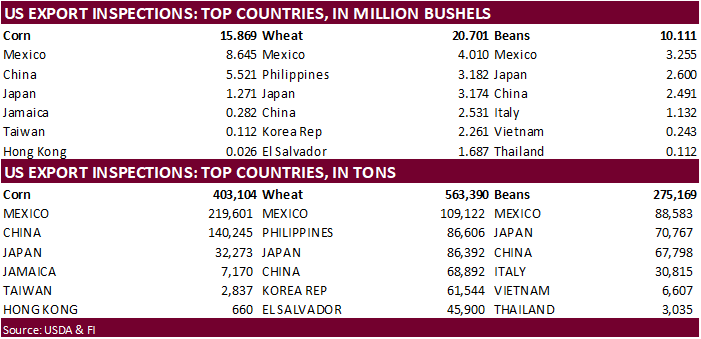
GRAINS
INSPECTED AND/OR WEIGHED FOR EXPORT
REPORTED IN WEEK ENDING SEP 16, 2021
— METRIC TONS —
————————————————————————-
CURRENT PREVIOUS
———–
WEEK ENDING ———- MARKET YEAR MARKET YEAR
GRAIN 09/16/2021 09/09/2021 09/17/2020 TO DATE TO DATE
BARLEY
0 0 0 6,550 5,727
CORN
403,104 159,429 768,084 601,986 1,991,594
FLAXSEED
0 0 0 24 389
MIXED
0 0 0 0 0
OATS
0 100 48 200 1,196
RYE
0 0 0 0 0
SORGHUM
8,130 4,526 71,844 13,973 177,405
SOYBEANS
275,169 193,429 1,390,521 498,952 3,707,394
SUNFLOWER
0 0 0 0 0
WHEAT
563,390 567,438 503,034 7,713,880 8,664,655
Total
1,249,793 924,922 2,733,531 8,835,565 14,548,360
————————————————————————-
CROP
MARKETING YEARS BEGIN JUNE 1 FOR WHEAT, RYE, OATS, BARLEY AND
FLAXSEED;
SEPTEMBER 1 FOR CORN, SORGHUM, SOYBEANS AND SUNFLOWER SEEDS.
INCLUDES
WATERWAY SHIPMENTS TO CANADA.
·
Corn traded lower for the third consecutive session on widespread commodity and equity selling.
·
Funds sold an estimated net 4,000 corn contracts.
·
RIN prices were under a good amount of pressure today. Ethanol RIN’s were around $1.06, down from $1.25 earlier this month.
·
USDA US corn export inspections as of September 16, 2021 were 403,104 tons, within a range of trade expectations, above 159,429 tons previous week and compares to 768,084 tons year ago. Major countries included Mexico for 219,601
tons, China for 140,245 tons, and Japan for 32,273 tons.
·
NOLA shipping concerns continue to weigh on prices. We are hearing there are several barges still stranded after settling on land after the river swelled.
·
Look for US field yield reports this week to again vary. Some are calling the US yield around 172-173 bu/ac but we are in the camp of near 177. USDA September was 176.3.
·
China’s north and southwest portions of the corn belt will see heavy rains during the first half of the workweek, delaying harvesting progress.
·
China August imports of US corn were 2.93 million tons, 17 percent higher than the previous record in July. Ukraine imports of corn fell 12% to 301,383 tons.
·
AgRural reported 22 percent of the summer corn crop planted as of Sep. 16.
·
Brazil may soon announce they plant to cut corn import taxes for 90 days.
·
Cattle on feed and the hogs & pigs reports will be released after the close on Friday.

European
Union Crop Monitor:
-Corn
yield 7.78 tons per hectare, down from a projected yield of 7.90 t/ha in August.
-Spring
barley yield 4.23 tons per hectare, down from a projected yield of 4.30 t/ha in August.
Export
developments.
-
None
reported
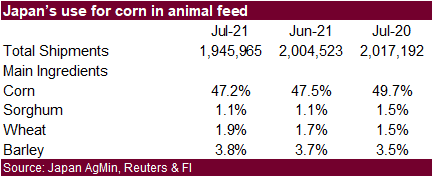
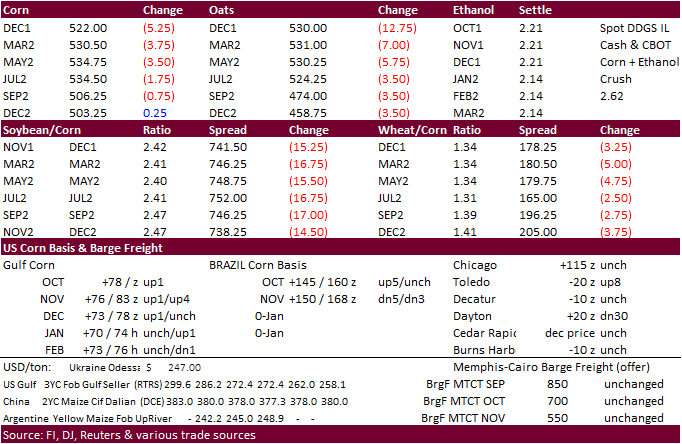
Updated
9/14/21
December
corn is seen in a $4.75-$5.75 range
Soybeans
·
November soybeans ended 21.50 cents lower at $12.62.50, a new short-term contract low. Soybean oil was down 121 to 139 points. Meal was $1.00-$2.50 lower.
·
Funds sold an estimated net 10,000 soybeans, 3,000 meal and 4,000 soybean oil.
·
USDA US soybean export inspections as of September 16, 2021 were 275,169 tons, within a range of trade expectations, above 193,429 tons previous week and compares to 1,390,521 tons year ago. Major countries included Mexico for
88,583 tons, Japan for 70,767 tons, and China for 67,798 tons.
·
Malaysian palm oil futures hit a 2-week low on Monday, settling at 4,173 ringgit, off 88. Cash palm fell $17.50/ton to $1,092.50/ton.
·
Malaysia left its October crude palm oil export tax unchanged at 8%. They raised their reference price of 4,472.46 ringgit ($1,068.18) per ton for October, up from 4,255.52 ringgit in September.
·
AmSpec reported Malaysian September 1-20 palm oil exports at 1.089 million tons, well up from 788,211 tons (38.2%) during the same period in August. ITS reported a 43.5 percent increase to 1.121 million tons.
·
China is on holiday through Tuesday, returning Wednesday.
·
China August soybean imports were down 1.2% from a year ago and the US share of Aug imports, of only 17,575 tons, fell to its lowest since November 2018 (Aug 2020 was 166,370 tons). China imported 9.04 million tons of Brazil
soybeans in August, up from 8.15 million year earlier, a 10.9% increase.
·
AgRural reported less than one percent of the Brazil soybean crop planted as dry and warm conditions are keeping producers out of fields. Producers are also cautious to avoid replanting due to very high input costs.
·
A S&P Global Platts survey sees India 2021-22 soybean production down 17 percent from 2020-21 to 10.8 million tons. Argentina soybean oil demand by India should remain strong in 2021-22.

Export
Developments
- Egypt’s
GASC seeks 30,000 tons of soyoil and 10,000 tons of sunflower oil on Wednesday for arrival Nov. 15-30 and/or Dec. 1-15.

Updated
9/14/21
Soybeans
– November $11.75-$13.75 range, short term $12.70-$13.30.
Soybean
meal – December $310-$385
Soybean
oil – December 53-62 cent range
·
Wheat prices traded lower led by the KC market (good planting weather). Prices likely followed corn and soybean lower along with a higher USD. Argentina’s wheat areas saw rain over the weekend bias La Pampa. Southern Brazil
also picked up on rain.
·
Funds sold an estimated net 6,000 soft red winter wheat contracts.
·
USDA US all-wheat export inspections as of September 16, 2021 were 563,390 tons, within a range of trade expectations, below 567,438 tons previous week and compares to 503,034 tons year ago. Major countries included Mexico for
109,122 tons, Philippines for 86,606 tons, and Japan for 86,392 tons.
·
The central US Great Plains will see favorable temperatures and dry conditions for hard red winter wheat planting progress this week.
·
Russian wheat export prices at the end of last week increased for the 10th consecutive week. SovEcon reported a $1.50 increase to $304.50/ton from the previous week and IKAR reported a $1.00 rise to $301/ton for 12.5% protein
Black Sea wheat for early October shipment.
·
December Paris wheat was down 1.75 at 245.75 euros.
·
We lowered our US all-wheat production estimate to 1.682 billion from 1.706 billion, based on minor adjustments to the spring wheat planted area and upward revisions to abandonment for the other spring and durum area. We took
down other spring wheat harvested area to 10.462 million acres from 11.215 million, and durum to 1.376 million from 1.444 million. Our spring wheat production is 322 million, down from 345 million previous and durum at 32 million from 34 million previous.
·
USDA is using 1.697 billion for all wheat, 343 million for spring and 35 million for durum.
·
Attached is our wheat production by class tables.
Export
Developments.
·
Algeria seeks 50,000 tons of durum wheat on September 22 for November shipment.
·
Jordan seeks 120,000 tons of feed barley on September 23 for Dec. 16-31, Jan. 1-15, Jan. 16-31, and Feb. 1-14.
·
Pakistan’s lowest offer for 500,000 tons of wheat was $383.50/ton c&f.
·
Turkey seeks 260,000 tons of feed barley on September 21 for October 8-October 31 shipment.
·
Mauritius seeks 47,000 tons of wheat flour, optional origin, on Sept. 21 for various 2022 shipment.
·
Morocco seeks 363,000 tons of US wheat on September 21 for arrival by the end of the year.
-
Jordan
seeks 120,000 tons of wheat on September 22 for LH December through FH February shipment.
-
Taiwan
seeks 49,580 tons of US wheat on September 23 between November 6 and November 20.
Rice/Other
·
Bangladesh seeks 50,000 tons of rice on September 23.

Updated
9/9/21
December
Chicago wheat is seen in a $6.50‐$7.80 range
December
KC wheat is seen in a $6.40‐$8.00
December
MN wheat is seen in a $8.45‐$9.50
Terry Reilly
Senior Commodity Analyst – Grain and Oilseeds
Futures International
One Lincoln Center
18 W 140 Butterfield Rd.
Oakbrook Terrace, Il. 60181
W: 312.604.1366
ICE IM:
treilly1
Skype: fi.treilly

Trading of futures, options, swaps and other derivatives is risky and is not suitable for all persons. All of these investment products are leveraged, and you can lose more than your initial deposit. Each investment product is offered
only to and from jurisdictions where solicitation and sale are lawful, and in accordance with applicable laws and regulations in such jurisdiction. The information provided here should not be relied upon as a substitute for independent research before making
your investment decisions. Futures International, LLC is merely providing this information for your general information and the information does not take into account any particular individual’s investment objectives, financial situation, or needs. All investors
should obtain advice based on their unique situation before making any investment decision. The contents of this communication and any attachments are for informational purposes only and under no circumstances should they be construed as an offer to buy or
sell, or a solicitation to buy or sell any future, option, swap or other derivative. The sources for the information and any opinions in this communication are believed to be reliable, but Futures International, LLC does not warrant or guarantee the accuracy
of such information or opinions. Futures International, LLC and its principals and employees may take positions different from any positions described in this communication. Past results are not necessarily indicative of future results.


